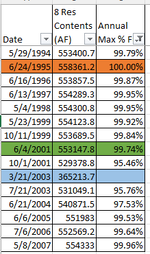I have a column of data created through prior if statements that contain either a value of zero, or a value greater than zero. I'm trying to create a new column that will count the days until the value is greater than 1. Below is an example of the data (Value column) and the result I'd like (count). I have a feeling this is a calculate with distinct count and some filter, but I can't seem to craft something that works.
In excel, I would simply start a formula in row 2 that was if(value>0,0,Count from row above + 1).
In excel, I would simply start a formula in row 2 that was if(value>0,0,Count from row above + 1).
| Values | Count |
| 0 | 1 |
| 0 | 2 |
| 0 | 3 |
| 0 | 4 |
| 0 | 5 |
| 0.987 | 0 |
| 0 | 1 |
| 0 | 2 |
| .99 | 0 |






